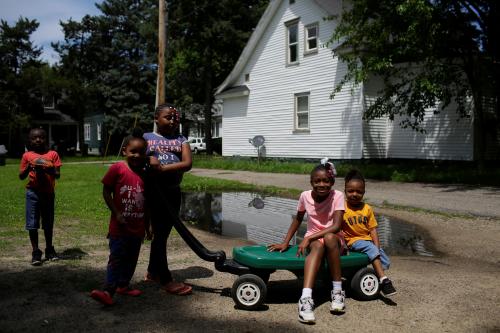A recent article in the Economist positioned the debate on social mobility in the United States with two leading economic views as fully representative. One view, grounded in dozens of analyses by Raj Chetty and colleagues of large administrative data, is that neighborhoods and place have an outsized influence in interfering with social mobility. This view points to the value of public investment in neighborhoods and housing with a particular lens on desegregation by race and social class. The other, grounded in analyses of evaluations of early childhood programs by James Heckman, is that children’s early learning environments—whether at home or in nonparental settings—have an outsized influence in shaping social mobility. This view points to the value of public investment in high-quality early education interventions, including home visiting but also preschool. These views—and the effort to present them as contradictions—are mostly right and also almost entirely wrong.
What is mostly right? Both Chetty and Heckman’s work conclusively point to the importance of early childhood circumstances in influencing subsequent well-being—whether the neighborhood one is born into or the early education and care received. It turns out that the zip code you are born in really does matter for later life chances, as does access to high-quality early learning experiences that can have impact through high school and beyond.
It is also mostly right that public investment in neighborhoods and safe, quality, stable housing, plus policies to support parenting and the quality of early care and education may show important economic returns in long-term social mobility.
What is entirely wrong? Social mobility is not privy to one solution, irrespective of the path of scientific evidence, policy agendas, or the prevailing views of certain economists. Indeed, as we have argued, moving the needle will require a multi-pronged approach where multiple pathways work in concert to ensure optimal environments for children to thrive.
Children are born into and grow up in complex environments and systems, and interact with multiple caregivers. Investment in early childhood will only go as far as co-investment in neighborhoods. Supporting housing and child care centers will only go as far as parents are employed and can pay for food on the table. Evictions spill over to family life and parenting of young children; unstable family income can jeopardize stable housing for young children, as well as early education providers slotted to provide high-quality care.
What this implies for policymakers is to look more broadly. Safety net and income security are typically not seen as social mobility investments for children, but they are. Important work by Hoynes, Schanzenbach and Almond shows that early access to the U.S. safety net (such as food stamps) can have long-term positive impacts on both health and economic self-sufficiency in adulthood. The earlier the access during children’s development, the more powerful these effects that expand to outcomes including health, economists Almond, Currie, and Duque further argue. As part of a study to assess the impact of poverty reduction, stable, monthly cash for the first 40 months of a child’s life is being awarded to low-income mothers.
K-12 education investments also matter. Educational opportunity is unequal in the U.S. Even with the best early education and care and the best neighborhoods and schools, children of color are often left behind. As a recent study by Jackson and Johnson demonstrates, K-12 education investment fills the pipeline to continued early care and education enrichment. Head Start’s long-term impacts on educational attainment, adult earnings, and reduced incarceration were enhanced when children were exposed to schools with greater Title I investments.
Access to post-secondary education and college degree completion continues to matter for subsequent earnings. Lack of continued investment risks undoing progress during children’s earlier years. Proposals to address this include those from scholars such as Dynarski and Kreisman on simplifying aid formulas and forgiving debt that especially harms students of color who are at most risk of default from relatively small loans; these students are also disproportionately enrolled in low-quality or for-profit colleges that saddle them with debt and poor credit ratings.
Economists have strong tools at their disposal to tackle thorny policy issues. Simplifying their argument into false dichotomies, however, does not pave the road to increased progress on the enduring challenges of social mobility. Instead, we need to apply broader models that consider smart investments throughout children’s development, including adolescence, and that adapt to the reality of household poverty and food insecurity. When these models are tested, we might learn about positive spillovers, or that certain families can thrive with certain combinations of solutions in certain contexts. Bringing together a diverse group of economists and experts spanning different disciplines will result in a more focused, yet comprehensive, approach to poverty and inequity.
The Brookings Institution is committed to quality, independence, and impact.
We are supported by a diverse array of funders. In line with our values and policies, each Brookings publication represents the sole views of its author(s).










Commentary
Progress on social mobility takes more than two viewpoints
July 15, 2020